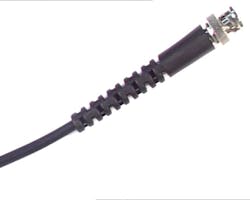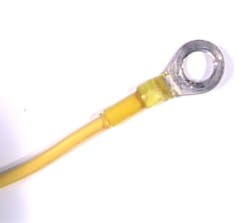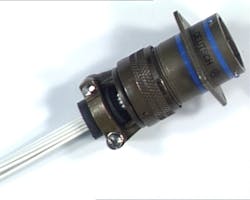By John Kuster, Senior Product Manager, Global Aerospace, Defense & Marine, TE Connectivity
My air compressor wasn’t working the other day so I unplugged it and took off the box cover to the wiring. I immediately saw a wire that was broken at the end of a terminal lug and I said to my son that this would not have happened if the company would have used some strain relief. He looked puzzled and asked how there could be strain inside the box. It made me stop and think about the words I used and what they really mean.
In the world of heat shrink materials we think of “strain relief” in a variety of aspects. On an individual wire it means using something for spreading out a force acting on the wire so as not to damage the insulation. This is technically called adding a “stress gradient” component. The purpose is to avoid buckling the insulation or conductor. The secret to a proper stress gradient is that it truly does spread the stress and not simply move it to another location on the wire.
Rigid material over conductor Flexible material over conductor
Sharp angle places compression and Tubing helps to distribute the stress
extension stress on the conductor. over a larger area.
The gradient material should be somewhat flexible so that stress can be absorbed by it and “relief” can be provided to the insulation on the wire. It should essentially increase the natural “bend radius” of the system to eliminate kinks in the wire. Many wire support glands are provided with a flex member that looks like a plastic coil spring that provides a tapered flexibility to a wire. There are many others designs in the market capable of performing this function such as an over-molded “waffle” strain relief as pictured below. The tapered serrations in this type of “waffle “ pattern allow for gradual bending to naturally occur.
Another benefit of strain relief is “vibration dampening.” As in the case of my compressor, vibration over a period of time took a toll on the wire conductor and strand-by-strand, it “work hardened” and fractured over time and finally failed in use. Insulated terminals or heat shrink tubing as shown below are a simple, inexpensive means of preventing this type of mechanical failure by supporting the crimped area of a wire at a terminal. Using an insulated lug with a pre-applied gel or adhesive inside will also seal the conductors from corrosion, further extending the protection to the circuit.
Heat shrinkable adhesive-lined terminals offer support against wire stress and prevent moisture intrusion.
Probably the most popular use of the term strain relief is for protection against a strong pull on the wire or cable. This type of strain relief is typically provided by a clamp or similar securing means that fits around the wire and secures it to a panel that the wire passes through. Common solutions for this type of strain support are molded connectors, backshell clamps, adhesives and potting, mechanical compression fittings or cord grips.
Elastomeric grommets (black insert) are used in saddle clamp backshells to bundle wires and provide cushioning from the rigid clamp.
The above example uses a polymeric cushion called a grommet to protect an open wire bundle from the harsh compression and strain of a saddle clamp backshell.
There are many other functions that can be added to a strain relief component. Products for EMI grounding and bonding, feedthrough sealing and wire bundling commonly provide strain relief in addition to their primary function. Many clamping and fastening products are designed as supports for wire routing, but act to relieve stress on wire bundles as well.
So I have to wonder if I used the correct words when describing my compressor failure to my son. I should be more careful in selecting my words when the need is not true strain relief but rather sealing, bundling, grounding, clamping, insulating, or dampening. I should probably apply this same caution to my dealings with my customers as well.
Author’s Bio
John Kuster is senior product manager for TE Connectivity’s Global Aerospace, Defense, & Marine business unit. John has more than 30 years’ experience in the electrical interconnect field specializing in electrical cable systems, heat shrinkable polymers and electrical harness systems. You can contact John at [email protected] or connect with John and other TE experts at www.designsmarterfaster.com.

Courtney E. Howard | Chief Editor, Intelligent Aerospace
Courtney enjoys writing about all things high-tech in PennWell’s burgeoning Aerospace and Defense Group, which encompasses Intelligent Aerospace and Military & Aerospace Electronics. She’s also a self-proclaimed social-media maven, mil-aero nerd, and avid avionics and space geek. Connect with Courtney at [email protected], @coho on Twitter, on LinkedIn, and on Google+.





